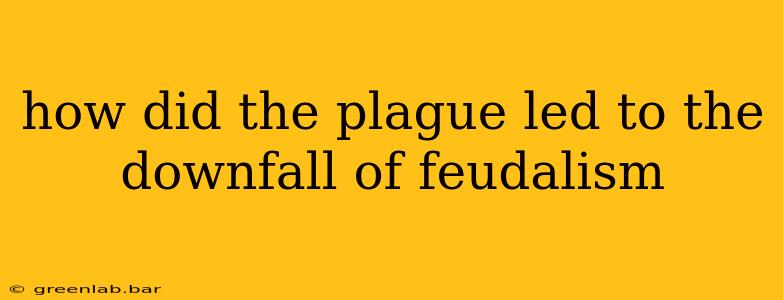The Black Death, a bubonic plague pandemic that ravaged Europe from 1346 to 1353, acted as a seismic event, irrevocably altering the social, economic, and political landscape of the medieval world. While not solely responsible for the decline of feudalism, the plague significantly accelerated its demise by disrupting its fundamental structures and power dynamics. This essay will explore the multifaceted ways in which the plague contributed to the eventual downfall of this medieval system.
The Crushing Blow to the Manorial System
Feudalism rested heavily on the manorial system, a self-sufficient agricultural economy centered around the lord's manor. Serfs, bound to the land, provided labor in exchange for protection and a portion of the harvest. The plague, however, decimated the population, often wiping out entire villages. This massive loss of life created a severe labor shortage, drastically weakening the manorial system's foundation.
The Rise of Peasant Power: A Shift in the Balance
With fewer peasants to work the land, those who survived suddenly held significant bargaining power. They could demand higher wages and better working conditions, effectively challenging the traditional lord-serf relationship. The lords, desperate for labor, were often forced to concede these demands, leading to a gradual erosion of serfdom and the dismantling of the rigid social hierarchy that underpinned feudalism. This marked a significant shift in power dynamics, empowering the peasant class and weakening the authority of the landed gentry.
Economic Disruption and the Decline of the Feudal Economy
The plague's economic impact was devastating. Trade routes were disrupted, agricultural production plummeted, and the overall economy suffered a severe contraction. This economic upheaval further destabilized the feudal system. The traditional system of land-based wealth and reciprocal obligations was thrown into chaos. The scarcity of labor and resources led to inflation and widespread economic hardship, weakening the very fabric of feudal society.
The Rise of a Money Economy: A New Era
The plague inadvertently hastened the transition from a largely barter-based economy to a money economy. The increased demand for labor led to the payment of wages in cash, a departure from the traditional system of labor services. This shift towards a monetary system further undermined the feudal structure, promoting individual economic freedom and reducing reliance on the lord-serf relationship.
Political Instability and the Weakening of Feudal Authority
The plague also significantly weakened the political authority of feudal lords. The deaths of numerous lords and the ensuing power struggles further destabilized the existing political order. The crown, often struggling to maintain control amidst the chaos, capitalized on the situation, centralizing power and expanding its influence at the expense of the feudal aristocracy.
The Crown's Consolidation of Power: A Centralized State Emerges
Kings and monarchs across Europe took advantage of the weakened feudal system to strengthen their own power. They implemented new taxes, created standing armies, and extended their administrative reach, further weakening the autonomy of local lords and solidifying the emergence of centralized nation-states. This centralization of power represented a pivotal step away from the decentralized, fragmented power structure inherent in feudalism.
Conclusion: A Catalyst, Not a Sole Cause
In conclusion, while the Black Death was not the sole cause of feudalism's decline, its impact was profound and far-reaching. The plague acted as a catalyst, accelerating existing trends and exacerbating pre-existing weaknesses within the feudal system. By disrupting the manorial system, triggering economic upheaval, and destabilizing the political order, the Black Death significantly contributed to the eventual downfall of feudalism and paved the way for the emergence of new social, economic, and political structures in Europe. The long-term consequences of this catastrophic event reshaped the course of European history, ushering in a new era marked by significant social and political transformations.

